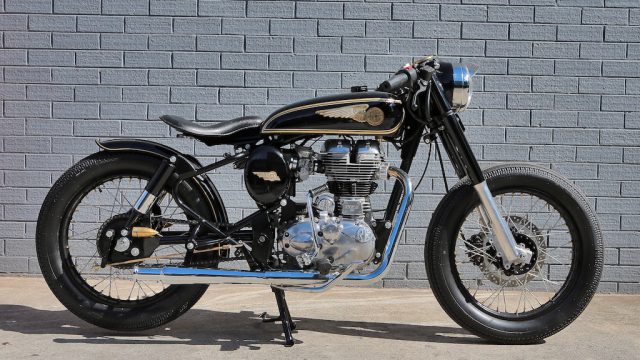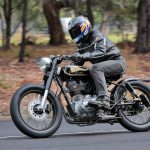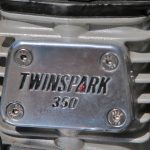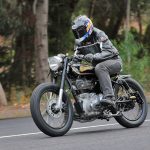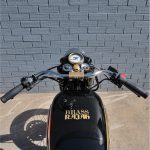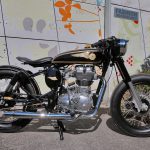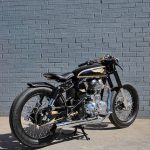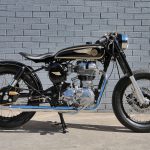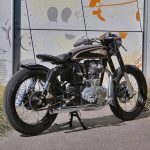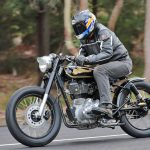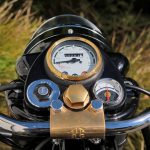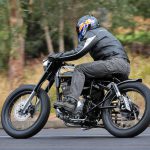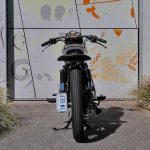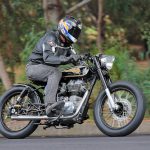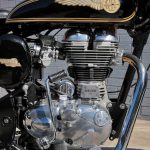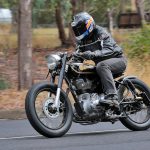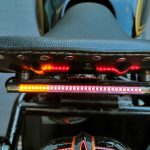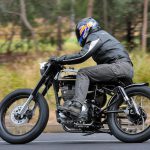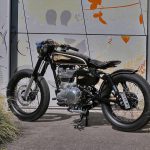Authentic modern Custom classic that provides the parent Royal Enfield company with the template to produce its single-cylinder equivalent of the best-selling Triumph Bobber
Royal Enfield’s unique status as a manufacturer whose entire product line consists of making yesterday live again but in a modern context, means that its bikes naturally lend themselves to period customising. Except you don’t need to worry about rejuvenating the worn-out mechanics of a yesteryear model when building an Enfield Custom – just take a brand new bike off a dealer’s showroom floor, and you’re ready to go. Hence the growing global trend for ever more of its air-cooled ohv pushrod singles to appear in highly modified and ultra personalised form, featuring in bike building competitions all over the world.
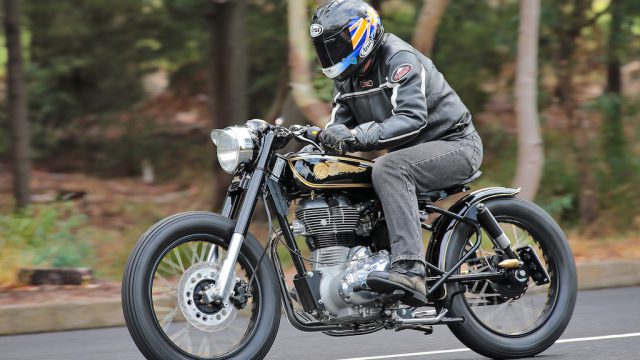
But it was for an RE-only such biker build-off staged by the Indian firm’s Down Under distributor Urban Moto Imports last year that Mid Life Cycles in Melbourne, Australia conceived and created its delectable bobtail RE350 Brass Rajah – one of eight entries for the contest from RE dealerships in both Oz and NZ, which had to be entirely constructed within a 31-day period, using a 350cc Classic model as the basis. (All the entrants’ bikes can be viewed by visiting the Royal Enfield Australia and New Zealand Facebook page, or Instagram #royalenfieldausnz). Yet even though it only gained the runner-up slot in the final judging, losing out to Royal Enfield Sydney’s entry named Rough Cut which narrowly won the online voting, such has been the demand for copies of the Rajah that Mid Life Cycles CEO Michael Catchpole has agreed to construct a series of these to special order, meaning that each bike can be tailored to the tastes of its customer.
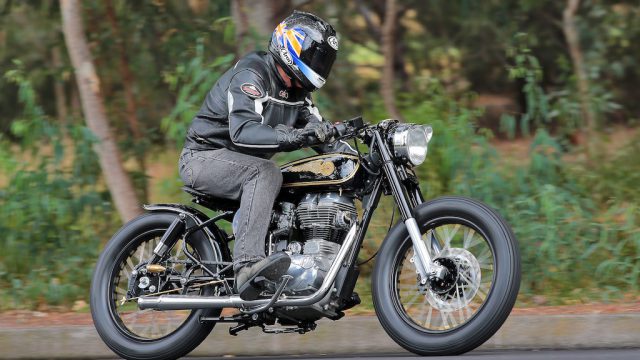
“Royal Enfield Sydney won the competition with a good bike that was very well marketed, and was all over social media,” says Michael Catchpole, 61. “Our friendly rivalry extended to the last two hours of voting, but the outcome was they got the nod, and good luck to them. But as a company which started out as a Classic bike restorer and Custom bike builder [see profile], from our point of view we achieved the purpose of showing what we could do with a Royal Enfield Classic. So we were delighted when after that the International online Custom blog Pipeburn www.pipeburn.com nominated us to be part of the judging for their 2016 Bike of the Year. What’s more, we made the top 10 in the final judging, which was a vindication of what we’d set out to do. That led to significant pressure from potential customers to buy Brass Rajah replicas, and we’re building two such bikes, plus we’re in final discussions for a third, all within the $15-20K Australian price range for a brand new Brass Rajah bobber as either a 350 or 500. One of the first two is not perhaps as ambitious as the show bike, and is being built for an owner who wants to ride it in a country town without drawing too much police attention – while getting lots of the good kind! So his would be what we’ll call a Rajah Lite, whereas the other one is an absolutely loaded full-on build with everything included, and a bit more besides. Each of them is challenging in its own way, because to keep even the less ambitious build somewhere close to meeting road-legal regulations for a new motorcycle is a real challenge in itself. But the bike’s aesthetic is the overriding factor – it has to be right, look right and ride properly.”
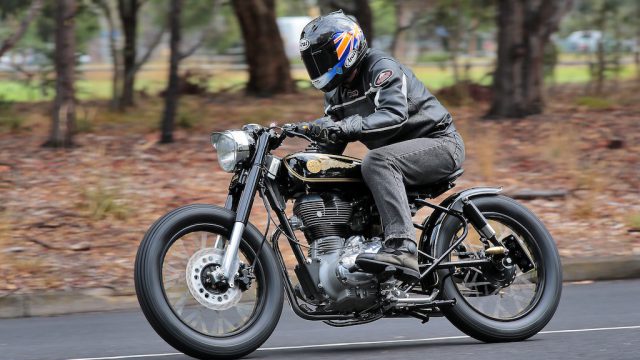
That it does, as I found for myself when Michael Catchpole let me loose to cruise the streets of Melbourne on the prize-winning prototype – a modern Aussie take using neo-vintage hardware from India on a Yankee-style hot rod that’s capable and competent, as well as dead cool-looking. For those unfamiliar with this iconic piece of two-wheeled Americana, the Bobber was the forerunner of today’s Custom bikes, initially concocted in the late Forties and early Fifties by GI’s returning home from the battlefield with accumulated war wages ready to be spent on a motorcycle. To do so, they invariably used a Harley-Davidson or Indian as the basis – but also vintage-era Triumph twins of the Marlon Brando/Wild One pre-Bonneville generation. But as more and more war veterans were demobbed, the massive shortage of civilian bikes ramped up prices, leading them to acquire now-unwanted military dispatch bikes which they then ‘bobbed’ by cutting back the rear fender, aka mudguard – hence the term ‘bobtail’ – as well as stripping off other unwanted parts to make the result as light as possible for street racing. Going from a dead stop to flat out as fast as possible was the bobber’s mantra, as practiced in the illegal street drags staged throughout the USA back then. There were plenty of uncompleted freeways comprising Eisenhower’s fledgling Interstate Highway System where you could drag race pretty safely – often for big money in side bets – before the freeways got completed and such racing got commercialised when they built special drag strips to take it off the streets. So a Bobber represented a minimalist approach to bike building that was made for go, not show, hence anything that didn’t constitute a necessity was deleted. Just like on the Brass Rajah…..
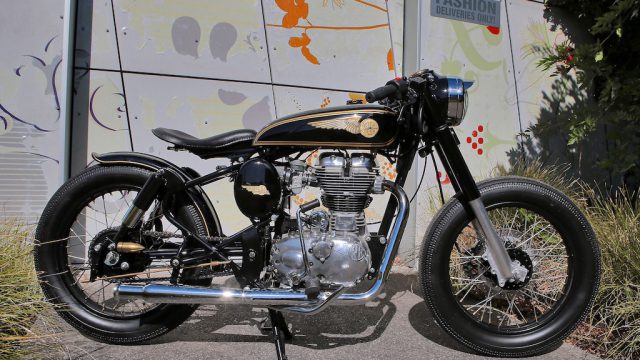
The Bobber later mutated into the Chopper in the Sixties – but that’s another story, though it’s worth noting that in today’s America the garish, raked-out custom Choppers that were all the rage a decade ago before the advent of sub-prime mortgages, are now so very yesterday, with the clone manufacturers who built them mostly gone to the wall, leaving the more minimalist and far more rideable Bobber-style Customs to enjoy a resurgence. Hence one of Harley’s recent best-sellers has been the Bobber-style Forty Eight, and Triumph’s authentically styled new Bonneville Bobber has become the fastest-selling model in the history of the brand. Mid Life Cycles’ Brass Rajah shows the Royal Enfield parent factory how they might achieve the same goal.
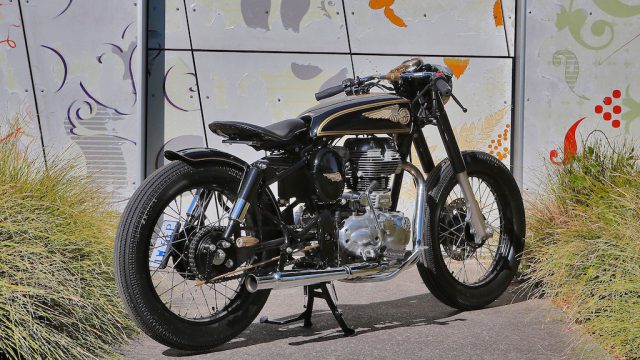
With the Brass Rajah, Catchpole & Co. aimed to build a bike that he says emphasised the design strengths of Royal Enfield’s Classic range, focusing on its upright, sculpted, timeless-looking ohv single-cylinder motor. “We took a brand new Royal Enfield Classic 350, sat it on the workshop floor, walked around it a few times, and then started pulling bits off it,” recalls Michael. “After stripping off all the many unwanted pieces and staring at the engine sitting high in the rolling frame, we realised we needed to visually lower and physically lengthen the profile of the bike.” First, the latter was achieved by lengthening the swingarm by 75mm with an all-new tubular steel design that was the handiwork of Hallam Racing’s Andrew Hallam, the co-designer 20 years ago of the remarkable Hunwick Hallam X1R V-twin Aussie Superbike.
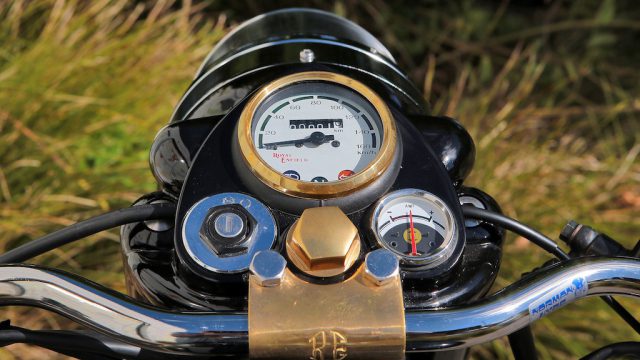
Next came the fuel tank. “The standard Royal Enfield Classic tank is nicely-shaped in side profile, but our build required a longer, leaner, lower tank,” says Catchpole. “We tried several possibilities, including some we had lying on the workshop shelves. None of them quite worked until we came across a replica 1930s Norton tank in a catalogue. With the 31-day build deadline shortening, it wasn’t till the box arrived and we sat the fully painted tank on the frame that we knew we had our solution. Project RE350 lived!” Catchpole then asked local painter Glen Stevens to delete the Norton branding by re-painting and pin-striping the tank to stay true to his original black-and-gold design brief, thus allowing the team to use the outrageously curvaceous Royal Enfield winged brass badges on the tank’s flanks.

Then the build team turned to the details. “Building a custom bike requires two things – a unifying central theme that helps define the build and keep it pure to the original intent; and hundreds of decisions about details,” says Catchpole. “From early on, we’d wanted some of those detail parts to be in brass to evoke the Art Deco era we wanted to position the bike in. From the brass tank badges, torpedo-shaped turn signals and extravagant wing-nut on the brass brake rod, through to the brass-rimmed custom speedo, the handlebar clamp and wire wheel spoke nipples, I reckon we’ve achieved our aim. We also had to give the bike a name, so what better after fitting all that than to call it the Brass Rajah!”
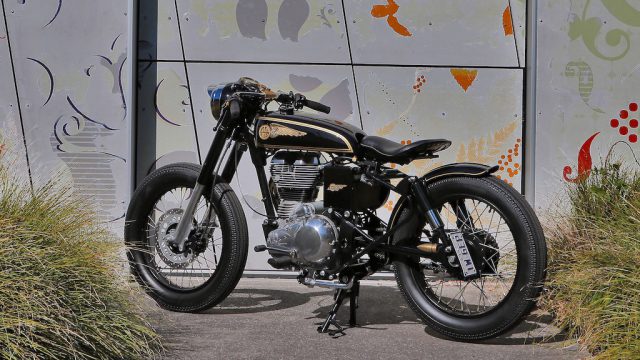
By this time, Catchpole & Co. had sourced many other parts including the shrouded BSA-style rear shocks replacing the stock coil-over units, thus ideally complementing the stock Royal Enfield shrouded front fork, and had stripped, powder-coated and rebuilt the wheels, fitting brass nipples on the stainless steel spokes. They’d also upsized the 350 Classic’s 18-inch rear wheel to a 19-incher. As one of the brands which Mid Life Cycles carries in stock, 4.00 x 19 Shinko E270 tyres were an obvious choice to support the 1940s Bobber look. The dropped one-piece handlebar and deep-dish leather seat were already in the dealership’s options catalogue, and had been fitted to several customer 350/500 Classics. However, Catchpole’s build team wanted to dispense with the standard springs beneath the seat, which they did by making up a temporary supporting frame, then commissioning local fabricator Paul Moneta of Fabwell to create a seat mount that follows the curve of the tyre-hugging rear mudguard, for which he also created the semi-hidden supports – another crucial element in the build.

This custom guard had to be carefully stretched and re-radiused to follow the profile of the re-laced 19-inch wheel sourced from a Royal Enfield Bullet 500. The team then fitted a horizontal strip of LED tail/brake lights beneath the seat, which as a result seems to be practically floating in thin air when viewed from the side. The separate LED indicator lights are tucked further up under the seat.
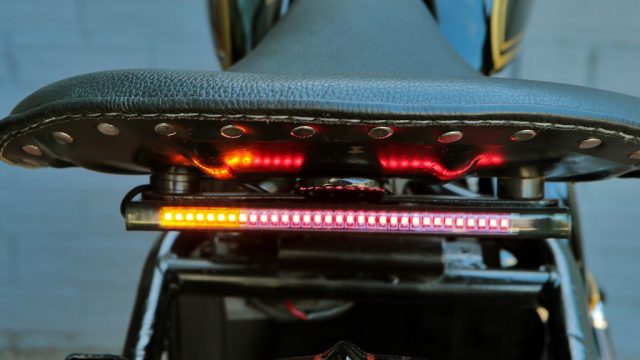
Climbing aboard the Rajah prior to thumbing the start button or kickstarting it into life – just to confirm how easy that is with the low 8.5:1 compression – revealed its leather seat to be incredibly comfortable while also looking cool. For once on a Custom bike, function follows form, making this an enjoyable ride running errands, or simply for café hopping. Think of it as a super-cool retro equivalent of a 400cc scooter The stretch to the dropped one-piece handlebar’s grips isn’t too excessive over the low, longer fuel tank, and it delivers a stance that’s relaxed as well as relatively sporty – contrary to what I was anticipating on first seeing the bike, it doesn’t put any excess weight on your arms and shoulders. The result is a Classic-era streetrod that’s fun to ride in town, where its light, nimble steering makes the Rajah a great tool for carving through traffic, aided by the ultra-light clutch action and the faultless shifting of its five-speed gearbox. In spite of the engine’s small capacity, its long 90mm stroke means there is pretty good torque throughout the rev range, although with barely 20bhp available from the 350cc pushrod motor you do have to work the gear lever quite hard to keep up with traffic on some of Melbourne’s broader boulevards. But that’s actually a pleasure because it shifts so well, and the muted but still vibrant thrum from the Rajah’s great-looking exhaust concocted by Mid Life Cycles using the stock header pipe coupled to its own chromed silencer, provides a pleasing soundtrack to your doing so. It has the look of a Bobber, but the performance and allure of a Café Racer, making it just as well that it stops OK, too – though you do have to use the small rear drum brake fairly hard to stop even reasonably well from any sort of speed, while at the same time squeezing the single-disc/twin leading-shoe front brake lever tight. But it all works OK, though you do need to plan ahead in stopping wherever possible.
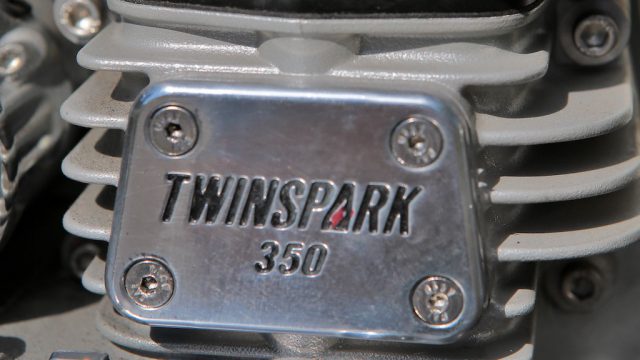
Another factor that makes the Brass Rajah fun to ride is the absence of any undue vibration from the air-cooled single-cylinder motor. It’s been years – decades, even – since I last rode a 350cc Royal Enfield as opposed to a 500, but that was one with an iron sleeve cylinder and separate gearbox with chain primary drive. The Indian firm’s huge step forward in 2009 with the launch of the current all-aluminium UCE motor (as in, Unit Construction Engine) transformed both the riding qualities and sense of sophistication of the air-cooled motor. No wonder that thanks to improved fuel economy – the no.1 issue for the Indian consumer – Royal Enfield’s 350cc models comfortably outsell the bigger 500cc versions today in RE’s Indian home market, where 96% of the more than 400,000 bikes built each year in its two Chennai factories, are currently sold. It was a pleasure to be propelled round the streets of Melbourne by the Rajah’s 350cc engine, and even at higher speed/revs it didn’t get stressed carving corners following the sweeps of the river in the Yarra Bend Park, or returning to Mid Life Cycles via the freeway, where it felt pretty long-legged. This is a great-looking but completely practical Custom motorcycle – the kind that Roland Sands, the LA-based fusion chef of Custom cool, would have been proud to have concocted himself. It’s a user as well as a looker.

And one that $15-20K Australian will buy you a replica of, depending on the spec chosen, which compared to anything over five times that amount for a US-made limited production large-cube V-twin like a Confederate Hellcat or Vanguard Roadster, seems almost a bargain for a hand-made Custom, albeit a pretty small-cube model. But Mid Life Cycles are now looking for more customers for Brass Rajah replicas, marrying Indian engineering with Australian flair. “The hardest part of the whole build has been to ensure that every step could be replicated cost-effectively to produce a limited series of practical and rideable Custom motorcycles using this same platform,” says Catchpole. “I’m glad to say we’ve achieved that, so we’re looking forward to building more Brass Rajahs, each of them different from one another.”
